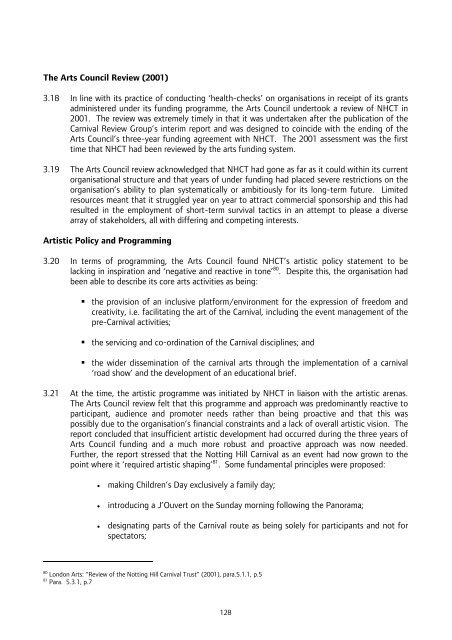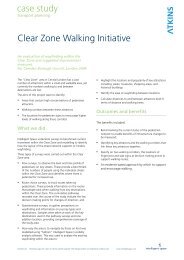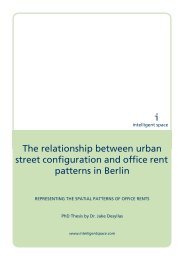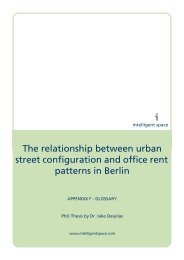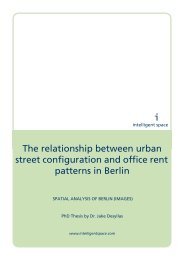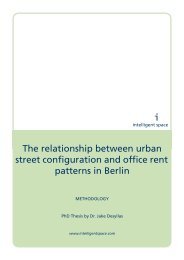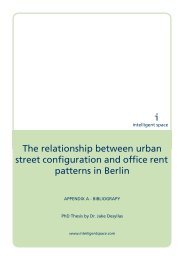Notting Hill Carnival Strategic Review - Intelligent Space
Notting Hill Carnival Strategic Review - Intelligent Space
Notting Hill Carnival Strategic Review - Intelligent Space
You also want an ePaper? Increase the reach of your titles
YUMPU automatically turns print PDFs into web optimized ePapers that Google loves.
The Arts Council <strong>Review</strong> (2001)<br />
3.18 In line with its practice of conducting ‘health-checks’ on organisations in receipt of its grants<br />
administered under its funding programme, the Arts Council undertook a review of NHCT in<br />
2001. The review was extremely timely in that it was undertaken after the publication of the<br />
<strong>Carnival</strong> <strong>Review</strong> Group’s interim report and was designed to coincide with the ending of the<br />
Arts Council’s three-year funding agreement with NHCT. The 2001 assessment was the first<br />
time that NHCT had been reviewed by the arts funding system.<br />
3.19 The Arts Council review acknowledged that NHCT had gone as far as it could within its current<br />
organisational structure and that years of under funding had placed severe restrictions on the<br />
organisation’s ability to plan systematically or ambitiously for its long-term future. Limited<br />
resources meant that it struggled year on year to attract commercial sponsorship and this had<br />
resulted in the employment of short-term survival tactics in an attempt to please a diverse<br />
array of stakeholders, all with differing and competing interests.<br />
Artistic Policy and Programming<br />
3.20 In terms of programming, the Arts Council found NHCT’s artistic policy statement to be<br />
lacking in inspiration and ‘negative and reactive in tone’ 80 . Despite this, the organisation had<br />
been able to describe its core arts activities as being:<br />
• the provision of an inclusive platform/environment for the expression of freedom and<br />
creativity, i.e. facilitating the art of the <strong>Carnival</strong>, including the event management of the<br />
pre-<strong>Carnival</strong> activities;<br />
• the servicing and co-ordination of the <strong>Carnival</strong> disciplines; and<br />
• the wider dissemination of the carnival arts through the implementation of a carnival<br />
‘road show’ and the development of an educational brief.<br />
3.21 At the time, the artistic programme was initiated by NHCT in liaison with the artistic arenas.<br />
The Arts Council review felt that this programme and approach was predominantly reactive to<br />
participant, audience and promoter needs rather than being proactive and that this was<br />
possibly due to the organisation’s financial constraints and a lack of overall artistic vision. The<br />
report concluded that insufficient artistic development had occurred during the three years of<br />
Arts Council funding and a much more robust and proactive approach was now needed.<br />
Further, the report stressed that the <strong>Notting</strong> <strong>Hill</strong> <strong>Carnival</strong> as an event had now grown to the<br />
point where it ‘required artistic shaping’ 81 . Some fundamental principles were proposed:<br />
• making Children’s Day exclusively a family day;<br />
• introducing a J’Ouvert on the Sunday morning following the Panorama;<br />
• designating parts of the <strong>Carnival</strong> route as being solely for participants and not for<br />
spectators;<br />
80<br />
London Arts: “<strong>Review</strong> of the <strong>Notting</strong> <strong>Hill</strong> <strong>Carnival</strong> Trust” (2001), para.5.1.1, p.5<br />
81<br />
Para. 5.3.1, p.7<br />
128


